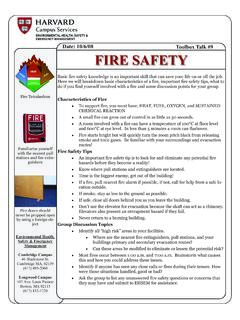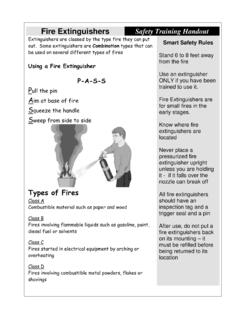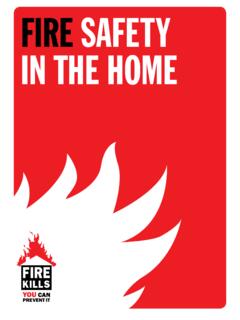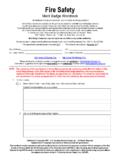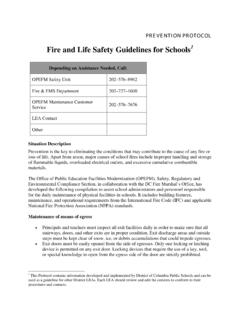Transcription of Fire Safety & NABH
1 NABH & fire Safety Fires can be devastating, especially in a hospital where a large number of people who need to be evacuated may be vulnerable immuno compromised, on life support, and incapable of moving on their own. There are special requirements that must be met with while evacuating such people in case of fire emergencies. But before that fires must be prevented . The part 4 of National Building Code of India 2005 on fire & Life Safety covers the requirements for fire prevention & life Safety in relation to fire and fire protection of buildings.
2 The Code specifies construction, occupancy and protection features that are necessary to minimize danger to life and property from fire . Buildings on the basis of occupancies have been divided into different groups in the chapter. Hospitals have been classified as sub-division C-1under Group C for Institutional Buildings with some specific requirements applicable for this category in addition to the general requirements common for all occupancies. The NBC gives detailed guidelines for Construction Materials, General Requirements for all buildings, Life Safety , fire Protection, Specific Occupancy wise Requirements and specific requirements for buildings above 15 meters.
3 The specific requirements for hospitals, in addition to the general requirements common to all buildings, as per NBC are: Minimum Requirements for fire Fighting Installations (NBC) Type of Installation Water Supply (In liters) Pump Capacity (in L/min) Type of Building/ Occupancy fire Extinguisher Hose Reel Dry Riser Wet Riser Downcomer Yard Hydrant Automatic Sprinkler System Manually operated Electric fire Alarm System Automatic Detection & fire Alarm System Underground static water storage tank Terrace tank Pump near underground static water storage tank with min pressure at terrace level At the terrace tank level with min pressure 2 Kg/cm2 INSTITUTION BUILDINGS a Hospitals, Sanitoria & Nursing Homes (C-1)
4 1 Less than 15 m in height with plot area up to 1000m2 i Up to ground plus one storey, with no beds R R NR NR NR NR R (NOTE 1) R NR NR 2500 (2500) SEE NOTE 2 NR NR ii Up to ground plus one storey with beds R R NR NR R NR R (NOTE 1) R NR NR 5000 (5000) SEE NOTE 2 NR 450(450) SEE NOTE 2 iii Ground plus 2 or more storeys, without beds R R NR NR R NR R (NOTE 1) R R NR 5000 (5000) SEE NOTE 2 NR 450 (450) SEE NOTE 2 iv Ground plus 2 or more storeys, with beds R R NR R NR NR R (NOTE 1) R R 50000 5000 (5000) SEE NOTE 2 NOTE 3 NR 2 Less than 15 m in height with plot area more than 1000m2 R R NR R NR R R (NOTE 1) R R 10000 10000 NOTE 3 NR 3 Above 15m height but not exceeding 24m in height R R NR R NR R R (NOTE 6)
5 R R 100000 20000 NOTE 4 NR 4 Above 15m height but not exceeding 30m in height R R NR R NR R R (NOTE 6) R R 150000 20000 NOTE 5 NR R = Required NR = Not required Note 1 Required to be installed in basement if area of basement exceeds 200m2 Note 2 Additional value given in parenthesis shall be added if basement area exceeds 200m2 Note 3 One electric & one diesel pump of capacity 1620 lpm and one electric pump of capacity 180 lpm Note 4 One electric & one diesel pump of capacity 2280 lpm and one electric pump of capacity 180 lpm Note 5 One electric & one diesel pump of capacity 2280 lpm and
6 One electric pump of capacity 180 lpm Note 6 To be installed at all floors at appropriate places and in consultation with local fire authorities Exit Facilities: In buildings or sections occupied by bed-ridden patients where the floor area is over 280 m2, facilities shall be provided to move patients in hospital beds to the other side of a smoke barrier from any part of such building or section not directly served by approved horizontal exits or exits from the first floor (floor 2) of a building to the outside.
7 Not less than two exits of one or more of the following types shall be provided for every floor, including basement, of every building or section: a) Doors leading directly outside the building; b) Stairways; c) Ramps; d) Horizontal exits; and e) fire tower. All required exits that serve as egress from hospital or infirmary sections shall be not less than 2 m in clear width including patient bedroom doors to permit transportation of patients on beds, litters, or mattresses.
8 The minimum width of corridors serving patients bedrooms in buildings shall be 2400 mm. For detailed information on recommendations for buildings and facilities for the physically handicapped, reference may be made to good practice [4(27)]. Elevators constitute a desirable supplementary facility, but are not counted as required exits. Patient lifts shall also be provided with enough room for transporting a stretcher trolley. Any area exceeding 500 m2 shall be divided into compartments by fire resistant walls.
9 Doors in fire resistant walls shall be so installed that these may normally be kept in open position, but will close automatically. Corridor door openings in smoke barriers shall be not less than 2000 mm in width. Provision shall also be made for double swing single/double leaf type door. Additional Precautions: No combustible material of any kind shall be stored or used in any building or section thereof used for institutional occupancy, except as necessary to normal occupancy and use of the building.
10 Bare minimum quantities of flammable material such as chloroform, ethyl alcohol, spirit, etc shall be allowed to be stored and handled. The handling of such liquids shall not be permitted by un-authorized persons. Bulk storage of these items, will be governed by relevant rules and safe practices. Exceptions and Deviations: It is recognized that in institutions or part of buildings housing various types of psychiatric patients, or used as penal and mental institutions, it is necessary to maintain locked doors and barred windows; and to such extent the necessary provision in other sections of the Code requiring the keeping of exits unlocked may be waived.


